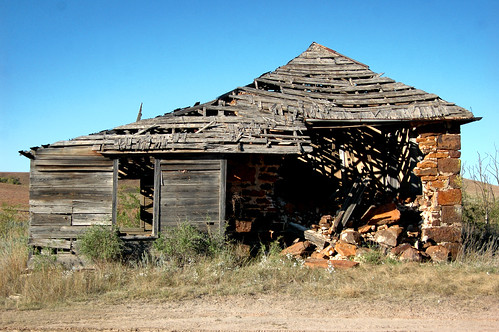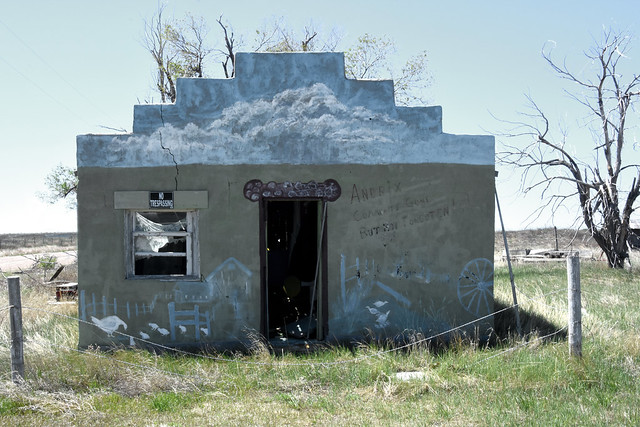Hardly ever, when we've been out "on the road" has there been a time when we've not passed the skeleton or rotting corpse of someone's old American dream. Husband has taken numerous photographs of these - they have a perverse kind of beauty. I picked out three or four which show a kind of progression. The first has husband measuring the dimensions of someone's first American dream-home:

The Höglund Dugout, Lindsborg, Kansas:
One of the more unusual and unexpected sights in Kansas is the Höglund Dugout. Even though it is not readily apparent on the beaten path, the grave-like home dwelling is remarkable and worth searching out as one tries to imagine residing years in a rock reinforced 6ft x
12ft hole in the ground.
Dugouts were not uncommon in the Midwest during the 19th century. A lack of building supplies, the price of lumber from the East and sparse growth of trees contributed to the phenomenon. In addition, most homes built above ground were produced cheaply with no insulation. The lumber homes were hot and dusty in the summer and cold and drafty in the winter. In contrast, a dugout constructed with and in sod was relatively snug and kept the harsh elements to a minimum. Normally "Scandinavian" dugouts, as they were known, were built into the side of a hill. There are examples of dugouts in Sweden, so perhaps this is where Midwest Scandinavian immigrants conceived and developed the idea. However, the Höglund family lacked an incline on their chosen plot of land and therefore dug down.
Other American dreamers had homes like these:


A home such as this one was, perhaps, the height of the American dreamer's aspirations:

The photograph below appeared in my post a couple of weeks ago, after our trip to the edge of Colorado. Husband has since found a little more of its story - it fits well here.

Andrix, the town that ran away from home:
From website :
Life Death Iron
Andrix was a tiny rural town in Las Animas County between Trinidad and Kim along Highway 160. Andrix served the needs of local farmers and ranchers, and once had a school, post office, church and a tiny store. A few scattered homes made up the rest of Andrix, and the population never amounted to much more than 50 or so. Andrix was typical of the many small rural communities found in Las Animas and Baca counties prior to the Dust Bowl years of the 1930âs.
Andrix struggled through the Dust Bowl and the depression, and the tiny general store was the center of activity in the town. A husband and wife ran the store starting in the late 1930âs. Barely eking out an existence, the couple remained faithful to the shrinking Andrix community, and kept a small inventory on hand to meet their needs.
The husband eventually passed away, his wife remaining in Andrix to run the store alone. In 1955 two locals robbed store and roughed up the poor widow (one of the robbers the widow had known since his birth) taking all the money she had to her name and stealing the few items left on her shelves. The thieves were apprehended down the road in Kim. The poor old widow never recovered from the shock of the robbery saying "The only place you are safe is heaven" although she remained faithful to her duty at the Andrix store, and was the last resident of the town in 1969.
The old Andrix store sits empty along Highway 160 today, a couple other structures, an abandoned car, and other refuse from the modern era mark the site. Someone, recently, has painted a memorial tribute to the Andrix community on the old storefront.





4 comments:
The Hoglund link completes the story...the dugout was the beginning of a future home above ground, a place to get started, with future, above-ground expansion in mind. Excerpt from the link: "The home was built over the Dugout serving as a root cellar for years, preserving it for future generations."
I grew-up in Kansas and these "root cellar starter homes" were very common, particularly in rural settings, but some existed in town. As you know from your twister experiences in OK, underground tornado-refuge is a must for about half of the year. If a person had money, they built a basement (aka root cellar) with a home on top. Those without built subterranean and expanded upward as money and time allowed. When I was a child, there were two recently built homes not far from mine that were complete homes, but only about two feet of the structure was visible above ground...the owners had no intention of building up.
We didn't have air conditioning, so I spent many scorchingly hot summer afternoons in our basement keeping cool, watching TV, playing games, eating lunch and-or dinner...it was the place to be. My neighborhood was mostly smaller homes, but many had finished basements, doubling the square footage of the home. It was common to have a bedroom "downstairs" and-or a rec-room (recreational room), along with a washer and dryer...the furnace and water heater were there, too.
The homes pictured in you post all endured the horrific dust storms of the 1930s. I read an excellent book about this duration, "The Worst Hard Time":
https://www.goodreads.com/book/show/72223.The_Worst_Hard_Time
and Ken Burns did an amazing PBS special called "Ken Burns: The Dust Bowl", available in various places (Netflix, DVD only).
mike ~ Thank you for your insights. I can't imagine how difficult it was in certain areas of the US before air conditioning became available. It's easy to see why most older houses have a front, and sometimes back, porch and as you said - a cellar; and why blinds as well as trees and bushes became a way of life for supplying shade to keep the heat down in homes as much as possible. Our remaining Cottonwood tree in the backyard does shade our roof some. When we eventually have to have it taken down (it's already sick in places) we'll definitely notice, heat-wise, in the house. :-(
I've never actually lived in a house with a cellar, but can imagine it'd be cool there.
The early settlers had to be made of strong stuff!
These images reminded me of a short film I saw recently on Vimeo, called, "A Town Runs Dry." It can be seen here: https://vimeo.com/165380902
Maybe in a few years this town, Stratford in California, will look like those properties. It's very sad.
RJ Adams ~ That does look like a future victim, for sure, and sad it is!
It's quite common in this part of the country - maybe all over the country - to find virtual ghost villages, or part-towns gone dead. The ones we notice most often seem to be victim of the railroad. When the railroads were first introduced, with passenger trains as well as freight trains, populations got excited, built or expanded small towns, built hotels - sometimes quite big hotels, in the expectation of a "boom". Booms maybe did come along for a time, but petered out as rail travel gave way to road travel.
Progress (or not!)
Post a Comment